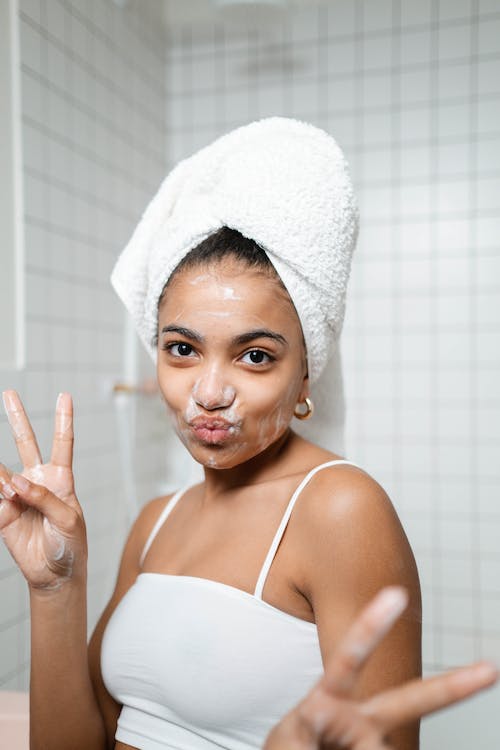Hyperpigmentation can be a distressing issue, particularly for those with darker skin tones. It often manifests as dark spots or patches on the face, commonly known as black discoloration. If you are struggling with hyperpigmentation, this article is here to help. I will share nine great hyperpigmentation treatments.
Many of us have experienced, at some point in our lives, certain areas of our skin becoming darker than the surrounding areas. These stubborn dark patches can be frustrating to deal with, making us question what’s causing them in the first place.
Causes of hyperpigmentation on the skin
Sun exposure
Excessive sun exposure triggers the production of melanin, the pigment responsible for skin color, leading to the formation of dark patches.
Wearing sunscreen, protective clothing, and hats while minimizing sun exposure can go a long way in preventing hyperpigmentation caused by the sun’s harmful rays.
Hormonal fluctuations
Ah, hormones—the regulators of everything inside our bodies. Pregnant women often encounter a specific type of hyperpigmentation known as melasma, affectionately referred to as the “mask of pregnancy.“
Fluctuations in estrogen and progesterone levels can stimulate melanin production, resulting in dark spots on the face. Birth control pills and hormone replacement therapy can also contribute to hyperpigmentation.
Post-inflammatory hyperpigmentation
That nasty acne breakout you had a few months ago might cause persistent dark spots on your face.
When the skin endures trauma, such as acne, burns, scratches, or even aggressive cosmetic treatments, it can respond by producing excess melanin, leading to post-inflammatory hyperpigmentation. Be gentle with your skin to avoid these unwelcome patches on your skin.
Genetic factors
Sometimes, it’s just in our genes. Certain genetic conditions and ethnic backgrounds are more prone to hyperpigmentation.
People with darker skin tones naturally have more active melanocytes, the cells responsible for producing melanin. Hence, they are more susceptible to hyperpigmentation triggered by various factors, such as sun exposure or skin inflammation.
External irritants
Our skin can be exposed to a lot of substances, products, and environmental factors that can result to hyperpigmentation.
Common culprits include certain medications, especially those used in chemotherapy, and toxic chemicals found in skincare products. It is essential to be cautious and opt for non-irritating, hypoallergenic products to minimize the risks.
Fortunately, there are effective treatments available to help combat hyperpigmentation and restore an even complexion. They include the following:
9 Best Hyperpigmentation Treatments
- Chemical Peels
- Topical Retinoids
- Microdermabrasion
- Laser Therapy
- Intense Pulsed Light (IPL)
- Natural Remedies
- Prescription Hydroquinone
- Combination Therapies
- Sun Protection
1. Chemical Peels
Brighten your skin with chemical peels! These treatments exfoliate the outer layer of the skin, effectively reducing the appearance of hyperpigmentation.
So, how do you use them? First, consult a dermatologist to know the right peel strength for your skin type. Wash or use a face cleanser for your face; avoid any other exfoliating products.
Apply the peel evenly, avoiding sensitive areas like your eyes. Leave it on for the recommended time, rinse it off, and follow up with a moisturizer.
2. Topical Retinoids
Use retinoids, commonly derived from vitamin A, to reverse hyperpigmentation. The ingredients in them help remove melanin buildup and promote cell turnover, leading to brighter, more even skin.
Best topical retinoids
i. Tretinoin (Retin-A): Is highly effective for treating acne. It’s available in various strengths, and requires a prescription.
ii. Adapalene (Differin): It has a lower risk of causing skin irritation and is suitable for those with sensitive skin.
iii. Tazarotene (Tazorac): Helps improve skin texture and reduce hyperpigmentation.
iv. Retinol: Retinol is a milder over-the-counter retinoid that can improve skin texture, reduce fine lines, and promote a youthful appearance.
3. Microdermabrasion
Smooth out hyperpigmentation concerns with microdermabrasion. By gently exfoliating the skin and stimulating collagen production, this treatment reveals a vibrant complexion while reducing the appearance of dark spots.
4. Laser Therapy
Get amazing results with laser therapy, specifically designed to target hyperpigmentation. The high-intensity light penetrates the skin and breaks down excess melanin, promoting a clearer and more radiant complexion.
5. Intense Pulsed Light (IPL)
IPL is one of the best hyperpigmentation treatments. This light-based treatment gradually heats the pigmented areas, stimulating the body’s natural healing process and helping to reduce dark spots over time.
6. Natural Remedies
Another way to treat hyperpigmentation is through the use of natural methods. Ingredients like kojic acid, licorice extract, and vitamin C have proven skin-brightening properties, effectively lightening hyperpigmentation and promoting a more uniform skin tone.
How to use:
a) Kojic Acid: Apply a kojic acid-containing cream or serum directly to the affected areas of the skin. Use it as directed, typically once or twice daily. Kojic acid works by inhibiting melanin production and slowly lighten dark spots.
b) Licorice Extract: You can find licorice extract in various skincare products. Apply a product containing licorice extract to the affected areas daily. It helps reduce inflammation, soothe the skin, and lighten hyperpigmentation.
c) Vitamin C: Use a vitamin C serum daily. Vitamin C has antioxidant properties that can brighten the skin and fade pigmentation. Apply it in the morning before your sunscreen.
7. Prescription Hydroquinone
Prescription-strength hydroquinone is a trusted way in treating hyperpigmentation. It limits melanin production, fading dark spots and restoring evenness over time. Remember to consult a dermatologist before starting this treatment.
8. Combination Therapies
Sometimes, to get rid of skin discoloration, you may use a combination method. Combination therapies, such as applying retinoids topically while undergoing laser treatments, can give more significant and longer-lasting results, especially for resistant hyperpigmentation.
9. Sun Protection
Prevent further hyperpigmentation by including sun protection into your skincare routine. The sun’s harmful rays can worsen existing dark spots and trigger the production of more melanin, so always use SPF 30 or higher, wear protective clothing.
Conclusion
Fighting hyperpigmentation and achieving an even complexion takes time and effort. However, if you stick to any of these treatment options, you will get a quick result.
Before you use any of these hyperpigmentation treatments, it is important that you understand the root causes and possibly avoid them. Also, consult a dermatologist if you need further guidance.

